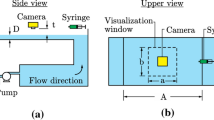Oil content plays an important role in oilfield wastewater treatment. To investigate the forecast of oil content by UV spectrophotometry, samples of oilfield wastewater are collected, and their UV transmittance and turbidity are measured. Partial least squares (PLS) and convolutional neural networks (CNN) based on a dataset of UV transmittance spectra are used for quantitative analysis in this work. The correlation coefficient between the oil content and turbidity of oilfield wastewater is 0.924, which shows a high positive linear correlation between the oil content and turbidity. Turbidity is added to the dataset to investigate its influence on the accuracy of prediction. The results show that the accuracy of models built by transmittance and turbidity is higher than that of models built by transmittance only, which is confirmed for both PLS and CNN. With the same dataset composition, the PLS and CNN models are nearly accurate, but the CNN performs slightly better overall. This work laid the foundation for the prediction of oil content in oilfield wastewater based on UV spectrophotometry and the further implementation of online detection.
Similar content being viewed by others
References
F. Al Jabri, L. Muruganandam, and D. A. Aljuboury, Global NEST J., 21, No. 2, 204–210 (2019).
Xu Shirong, Duan Ming, and Zhang Jian, Chem. Eng. Oil and Gas, 38, No. 3, 258–261 (2009).
C. Y. Wang, H. H. Jiang, J. W. Gao, J. L. Zhang, and R. E. Zheng, Spectrosc. Spectr. Anal., 26, No. 6, 1080–1083 (2006).
Yang Haiya, Wu Liangzhuan, Yu Yuan, and Zhi Jinfang, Chin. J. Spectrosc. Lab., 28, No. 6, 2770–2773 (2011).
P. D. Wentzell, D. T. Andrews, J. M. Walsh, J. M. Cooley, et al., Can. J. Chem., 77, No. 3, 391–400 (1999).
X. Bian, S. Li, L. Lin, X. Tan, Q. Fan, and M. Li, Anal. Chim. Acta, 925, 16–22 (2016), doi: https://doi.org/10.1016/j.aca.2016.04.029.
Xiaojun Tang, Angxin Tong, Feng Zhang, and Bin Wang, Sains Malaysiana, 49, No. 8, 1773–1785 (2020).
P. Li, J. Qu, Y.He, Z. Bo, and M. Pei, RSC Adv., 10, No. 35, 20691–20700 (2020), doi: https://doi.org/10.1039/c9ra10732k.
W. S. Jia, H. Z. Zhang, J. Ma, G. Liang, J. H. Wang, and X. Liu, Spectrosc. Spectr. Anal., 40, No. 9, 2981–2988 (2020).
X. W. Chen, G. F. Yin, N. J. Zhao, T. T. Gan, R. F. Yang, W. Zhu, J. G. Liu, and W. Q. Liu, Spectrosc. Spectr. Anal., 39, No. 9, 2912–2916 (2019).
Wu Decao, Wei Biao, Tang Ge, Feng Peng, Tang Yuan, Liu Juan, and Xiong Shuangfei, Acta Opt. Sin., 37, No. 2, Article ID 0230007 (2017).
Y. Hu and X. Wang, Sensors and Actuators B: Chem., 239, 718–726 (2017), doi: https://doi.org/10.1016/j.snb.2016.08.072.
E. Carré, J. Pérot, V. Jauzein, L. Lin, and M. Lopez-Ferber, Water Sci. Technol., 76, No. 3, 633–641 (2017), doi: https://doi.org/10.2166/wst.2017.096.
B. Chen, H. Wu, and S. F. Y. Li, Talanta, 120, 325–330 (2014), doi: https://doi.org/10.1016/j.talanta.2013.12.0.
X. Liu and L. Wang, Water Sci. Technol., 71, No. 10, 1444–1450 (2015), doi: https://doi.org/10.2166/wst.2015.110.
J. C. Cancilla, R. Aroca-Santos, K. Wierzchoś, and J. S. Torrecilla, Chemom. Intell. Lab. Systems, 156, 102–107 (2016), doi: https://doi.org/10.1016/j.chemolab.2016.05.
Y. Chen, L. Song, Y. Liu, L. Yang, and D. Li, Appl. Sci., 10, No. 17, 5776 (2020), doi: https://doi.org/10.3390/app10175776.
G. Puertas and M. Vázquez, J. Food Comp. Anal., 86, Article ID 103350 (2020), doi: https://doi.org/10.1016/j.jfca.2019.10335.
B. Wei, K. Hao, X. Tang, and Y. Ding, Textile Res. J., Article ID 004051751881365 (2018), doi: https://doi.org/10.1177/0040517518813656.
L. Norgaard, A. Saudland, J. Wagner, et al., Appl. Spectrosc., 54, No. 3, 413–419 (2000).
F. Al Jabri, L. Muruganandamand, and D. A. Aljuboury, Global NEST J., 21, No. 2, 204–210 (2019).
Author information
Authors and Affiliations
Corresponding author
Additional information
Abstract of article is published in Zhurnal Prikladnoi Spektroskopii, Vol. 90, No. 4, p. 661, July–August, 2023.
Rights and permissions
Springer Nature or its licensor (e.g. a society or other partner) holds exclusive rights to this article under a publishing agreement with the author(s) or other rightsholder(s); author self-archiving of the accepted manuscript version of this article is solely governed by the terms of such publishing agreement and applicable law.
About this article
Cite this article
Wang, Q., Li, H., Qi, H. et al. Forecast of Oil Content in Oilfield Wastewater by PLS and CNN Based on UV Transmittance Spectrum and Turbidity. J Appl Spectrosc 90, 924–930 (2023). https://doi.org/10.1007/s10812-023-01615-6
Published:
Issue Date:
DOI: https://doi.org/10.1007/s10812-023-01615-6




